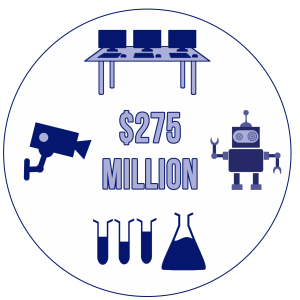To Pass Or Not to Pass: Measure CC
November 4, 2018
The tut-tut-tut of a jackhammer harmonizes with the roar of a drill and the high-pitched screaming of a truck in reverse gear — just as this concert begins to come to an end, the conductor introduces another measure: Measure CC of FUHSD.
To some, FUHSD’s Measure CC may be just another item on the Nov. 6 ballot, but to the current and future students who walk the Lynbrook campus and experience its facilities for seven hours each day, Measure CC could significantly affect their lives.
The current construction at Lynbrook is the work of Measures B and K of 2008, which collectively cost $493 million and provided funding for a field house addition, new cafeteria and quad, renovated gym lobby, frontage redesign, sports fields and solar panels.

Measure CC is a $275 million modernization bond for FUHSD schools that, if passed, will take effect starting summer 2020. At Lynbrook, Measure CC will focus on classroom and facility upgrades in wings 70, 100, 200, 300, 400, 500 and 600. It will also include modernized science labs, repairs on leaky windows and roofs, renovation of old plumbing and Heating, Ventilation and Air Conditioning (HVAC) systems, seismic upgrades, improved safety and security systems and improvement of facility access for those with disabilities, as well as a Science, Technology, Engineering and Mathematics (STEM) Maker Space and robotics center and field upgrades.
 “Facility infrastructure and modernization are needed at the aging high schools in the FUHSD,” said Assistant Superintendent Graham Clark. “Monta Vista, Lynbrook and Homestead High are approximately 50 years old.”
“Facility infrastructure and modernization are needed at the aging high schools in the FUHSD,” said Assistant Superintendent Graham Clark. “Monta Vista, Lynbrook and Homestead High are approximately 50 years old.” 
Those who support Measure CC believe that the bond will provide the financial resources necessary to better support Lynbrook’s various programs.
“I think the modernization and upgrading of facilities is necessary,” said community member Maya Baba. “Measure CC will provide the funding needed for this. I support Measure CC, and I hope the community will too. The staff and students will benefit from these infrastructure upgrades and modernization. This has a positive impact on the neighborhood, as we will have state-of-the-art facilities to continue the good work of our students.”
 Some members of the community, however, oppose Measure CC. A possible reason for opposition is as follows: Proposition 30 of 2012, the Education Protection Account, is a safeguard to ensure that schools are given substantial budgets. In addition, Proposition 2 of 2014 allows for excess taxes to go into a school reserve fund, with the state of California predicting that it will receive over $2.4 billion in school reserve funding by 2019, which some believe is sufficient funding for quality education, making Measure CC superfluous.
Some members of the community, however, oppose Measure CC. A possible reason for opposition is as follows: Proposition 30 of 2012, the Education Protection Account, is a safeguard to ensure that schools are given substantial budgets. In addition, Proposition 2 of 2014 allows for excess taxes to go into a school reserve fund, with the state of California predicting that it will receive over $2.4 billion in school reserve funding by 2019, which some believe is sufficient funding for quality education, making Measure CC superfluous.
 At the end of the day, it is up to the voters of the community to decide whether Measure CC will pass; as for students, although many are still unable to vote, they can educate themselves and others about measures like Measure CC that will have an impact on their community.
At the end of the day, it is up to the voters of the community to decide whether Measure CC will pass; as for students, although many are still unable to vote, they can educate themselves and others about measures like Measure CC that will have an impact on their community.



























































